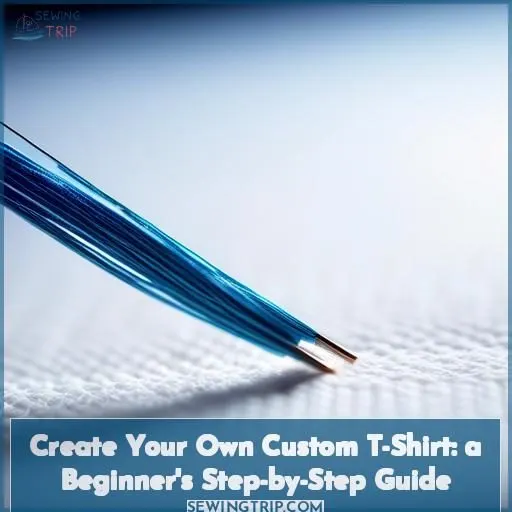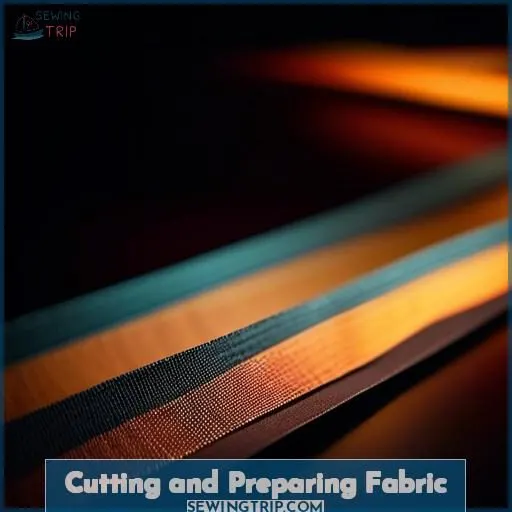This site is supported by our readers. We may earn a commission, at no cost to you, if you purchase through links.

To sew a t-shirt, you’ll need the right knit fabrics like cotton or rayon jersey, a sewing machine for knits, fabric scissors, and notions.
Trace a well-fitting t-shirt to create a custom pattern, then cut your fabric precisely.
Stabilize shoulder seams with interfacing or tape before sewing them together and attaching the sleeves.
Use a stretch stitch and gently pull fabric when sewing curved areas.
Finish with a coverstitch hem or serged seams for a professional look.
With some practice on stabilizing and stretching knits, you can achieve your dream custom-fitted tee.
Let’s embark on the complete step-by-step guide.
Table Of Contents
Key Takeaways
- Choose the right fabric for your project, considering breathability, drape, wrinkle resistance, and durability.
- Gather necessary sewing supplies, including a sewing machine for knits, fabric scissors, and notions.
- Create a custom pattern by tracing a well-fitting t-shirt and adjusting it for a perfect fit.
- Sew the t-shirt together using a stretch stitch, stabilizing shoulder seams with interfacing or tape, and finishing with a coverstitch hem or serged seams.
How to Sew a T Shirt?
To sew a t-shirt, start by pinning the shoulders of the body pieces together with the right side facing inwards.
Then, use a straight stitch to sew along both shoulder seams.
Next, prepare the neckband by folding it in half lengthwise and pressing it with a hot iron.
Attach the neckline by sewing the neckband to the raw edge of the shirt, using a zig-zag stitch.
Add sleeves by pinning them to the armholes and stitching them with a straight stitch.
Finally, sew down both sides of the shirt and add hems to the bottom and sleeves.
Selecting the Right Materials
When sewing your own custom t-shirt, you’ll need to select the right fabric type and gather the necessary sewing supplies. Cotton, rayon, and bamboo jerseys are all great choices for creating soft, comfortable t-shirts, and you’ll want to have basics like thread, scissors, and a ball-point needle on hand.
Choosing Fabric Types
To create a perfect custom t-shirt, the first step is to select the right fabric. Here are some tips on choosing the best fabric for your project:
- Breathability: Look for fabrics that are lightweight and breathable, such as cotton jersey, bamboo jersey, or rayon jersey. These materials will keep you cool and comfortable, especially during warmer months.
- Drape: Consider the drape of the fabric, which refers to how it hangs and moves on the body. Jersey fabric, whether single or interlock, is known for its excellent drape, making it ideal for creating a flattering fit.
- Wrinkle Resistance: Choose fabrics that are wrinkle-resistant, like polyester or interlock fabric, to minimize the need for ironing and maintain a crisp appearance.
- Durability: Opt for fabrics that are durable and can withstand frequent wear and washing, such as interlock fabric or a cotton-polyester blend.
- Cotton Jersey vs. Interlock Fabric: Both fabrics have their advantages. Single jersey is lightweight and soft, while interlock fabric is thicker and more stable, offering better wrinkle resistance. Choose the one that best suits your needs and the desired look for your t-shirt.
Gathering Sewing Supplies
To craft your ideal custom t-shirt, you’ll require a diverse array of sewing supplies. Here’s a catalog of indispensable items:
- Sewing Machine: Select a machine adept at handling knit fabrics and equipped with a zigzag stitch for elasticity.
- Fabric Scissors: These are ideal for sectioning your fabric and other materials.
- Measuring Tape: Precisely determine the dimensions of your fabric and pattern pieces with this tool.
- Thread: Coordinate the thread hue with your fabric for a harmonious appearance.
- Needles: Employ a sharp needle specifically designed for sewing knit fabrics.
- Fabric: Opt for an elastic knit fabric such as t-shirt jersey or interlock for your t-shirt.
- T-Shirt Patterns: Choose a pattern that aligns with your aesthetic preferences and skill level.
- T-Shirt Sewing: Adhere to the guidelines provided in the article for sewing your t-shirt.
Remember to always pre-wash your fabric to avert shrinkage and secure a perfect fit. Enjoy the process!
Creating a T-Shirt Pattern
To create your own custom t-shirt pattern, start by tracing a well-fitting t-shirt you already own. Then, adjust the pattern to get the perfect fit for your body by making alterations to the neckline, armholes, and length.
Tracing a Fitting T-Shirt
To trace a fitting T-shirt and create a pattern, follow these steps:
- Choose the right T-shirt: Select a well-fitting T-shirt that you want to replicate. It should be a comfortable size and style that you like.
- Lay it flat: Fold the T-shirt in half along the center front and back, aligning the folded edge with the grainline. This will help you trace the pattern accurately.
- Trace the bodice: Start by tracing the folded edge of the bodice, using a straight ruler for a clean line. Continue tracing along the hem, side seam, and shoulders.
- Copy sleeves and neckline: If the T-shirt has sleeves and a neckline, you can use two methods to trace them:
- Pull back the seamline: Carefully pull back the area attached to the seamline and trace as close as possible to the seam. This method works well for curved lines like necklines and collars.
- Use a tracing wheel: Roll a tracing wheel along the seamline to mark through to the paper. If you don’t have a tracing wheel, you can also use a pin to dot along the seamline for a similar result.
- Label pattern pieces: After tracing each piece, label them with the name of the garment, pattern piece type, cut number, fabric type, and orientation if applicable. This will help you keep track of which piece is which.
- True seams: Walk and true your seams that adjoin together to guarantee that everything lines up and will sew up correctly. This may involve lengthening or shortening lines as needed.
Remember to pay attention to the grainline and selvage when laying out your pattern on the fabric. Also, consider stabilizing shoulder seams with Pellon tricot interfacing or SewKeysE Stay Tape to prevent stretching.
Adjusting Pattern for Custom Fit
Customizing a t-shirt for a perfect fit is essential for creating a comfortable and stylish garment. Here are some techniques for adjusting shoulder seams, creating a customized neckline, altering sleeve length, and modifying armhole shape:
-
Adjusting shoulder seams: To rectify forward shoulder issues, shift the shoulder (outer) part of the shoulder seam in the direction of the front. This entails removing the front shoulder and extending the back shoulder. You can determine the necessary adjustment by gauging the distance from your shoulder point to the outermost edge of the shoulder seam.
-
Creating a custom neckline: To lower the neckline, sketch a new neckline on your pattern piece. Measure the desired amount of lowering and incorporate it into the pattern. You can also employ a curved ruler or trace the neckline on yourself for a comfortable fit.
-
Altering sleeve length: To adjust the length of the sleeves, modify the sleeve pattern piece. You can either shorten or lengthen the sleeves by moving the armhole seam upwards or downwards as required.
-
Modifying armhole shape: If you desire a wider armhole, begin sketching your neckline within the shoulder length. This will enable you to create a wider armhole without impacting the neckline shape.
-
Fixing body measurements: If your body measurements don’t correspond with the pattern, you can make adjustments to the side seams and dart positions. For example, if the pattern is too tight in the bust area, you can add a dart to the front bodice.
Remember to create a muslin or test garment before cutting into your final fabric to verify that the adjustments are as expected. Enjoy the sewing process!
Cutting and Preparing Fabric
Pay close attention to how you layout and cut your fabric. Marking and stabilizing the fabric are essential steps before sewing your custom t-shirt.
Layout and Cutting Techniques
Creating a custom T-shirt necessitates the optimal fabric layout. Initially, observe the selvage and align pattern pieces accordingly. Secondly, avert fabric overhang to prevent elongation.
Thirdly, employ interlock fabric for novice sewers. Lastly, fortify shoulder seams with interfacing or tape.
Bear in mind, elasticity and binding are pivotal when working with knits; hence, utilize ball point needles for an impeccable finish.
Marking and Stabilizing Fabric
To explore and secure your fabric for sewing, you’ll need some essential supplies. First, select a fabric marking tool that meets your requirements. Erasable markers are ideal for temporary markings, while permanent markers are preferable for enduring designs. For knit fabrics, you might want to investigate using a chalk pencil or a vanishing ink pen, as these can be conveniently removed without harming the fabric.
Next, contemplate employing stabilizers to aid in managing the elasticity of your knit fabric. Pellon tricot interfacing or SewKeysE Stay Tape can be utilized for shoulder seams and crotch seams, while SewkeysE Extremely Fine Fusible Knit Stay Tape is perfect for narrow or very wide hems on knit and lightweight fabrics.
When working with stretchy knit fabrics, it’s imperative to employ the appropriate stitch, needle, and techniques. A serger can be used for steps 1-7, while a cover stitch setting can be implemented for a double stitch on top and a chain stitch on the inside. A ballpoint needle is recommended for both sewing and embroidery on knit fabrics, as it offers more uniform stitches.
For sewing stretchy knit fabrics, utilize a walking foot for slinkier knits, and contemplate using a zigzag stitch or overlock stitch for seams. When attaching necklines, fold ribbing in half lengthwise and press, then match pins with t-shirt pins and stretch and sew around the neckline using a zigzag stitch.
Remember to take into account the selvage and arrange pattern pieces accordingly, and never allow fabric to hang over the edge to prevent stretching. Consider using interlock fabric for beginners, and reinforce shoulder seams with Pellon tricot interfacing or SewKeysE Stay Tape.
Sewing the T-Shirt Together
You’ll begin sewing the t-shirt together by joining the shoulder seams, being careful to match up the notches or markings you made earlier. Next, pin and sew the sleeves to the armhole openings, stretching the fabric slightly as you sew to guarantee a smooth fit.
Sewing Shoulder and Side Seams
To sew shoulder and side seams on stretch knit fabrics, follow these steps:
- Choose the right stitch: Use a straight stitch or a stretch stitch, such as a zigzag stitch, for sewing stretch knit fabrics. A zigzag stitch with twin needles can provide additional stretch.
- Use a double needle: A double needle can create a coverstitch hem, which is commonly found on T-shirt hems. Stitching from the top side, position the raw edge of the hem directly underneath and between the two needles to allow the raw edge to be incased by the zig-zag on the reverse side.
- Consider serging: Use a 3-Thread or 4-Thread serger stitch for steps 1-7, and a Cover Stitch setting for a double stitch on top and chain stitch on the inside. Consult the serger manual for specific instructions.
- Stretch the fabric: Stretch the fabric slightly while sewing.
- Sew the side seams: Pin and sew the side seams.
- Sew the bottom seam of the arm: Sew the bottom seam of the arm, ensuring that the fabric is stretched slightly while sewing.
Remember to pay attention to seam allowances and fabric stretching when sewing shoulder and side seams. Use interfacing options, such as Pellon tricot interfacing or SewKeysE Stay Tape, to stabilize shoulder seams. Mark the inside of the fabric with a fabric marking pen to guarantee accuracy.
Attaching Sleeves
Attaching sleeves to a t-shirt is a critical step in the sewing process. To guarantee a perfect fit, you need to think about sleeve length, sleeve width, sleeve shaping, and sleeve style. Here are some tips for sewing sleeves onto your t-shirt:
- Select the right sleeve fabric: Choose a fabric that matches the t-shirt’s style and is appropriate for the sleeve style you’re using. For example, a knit neckband would be best for a t-shirt with a knit neckline.
- Secure the sleeve to the armhole opening: Before sewing, attach the sleeve to the armhole opening, making sure the correct sides of the fabric are facing each other and the raw edges are lined up.
- Sew slowly and inspect the bottom layer: Sew the sleeve onto the t-shirt using a zigzag stitch, checking the bottom layer often to make sure it’s not folded or bunched.
- Remove pins as you sew: As you sew, take out the pins to prevent them from getting caught in the stitch.
- Fold over the sleeve: Once the sleeve is attached, turn the ends over to finish the seams.
Adding the Neckline
Now that you’ve attached your sleeves, it’s time to add the neckline. You’ll need a strip of fabric for neck binding, matching cotton thread, and a zigzag stitch.
For a mock turtleneck, fold ribbing in half lengthwise and press. Mark the fold and seam allowance, then fold in half again and mark the fold lines. Match ribbing pins with t-shirt pins, stretch and sew around the neckline using a zigzag stitch.
For a crew neck, scoop neck, V-neck, or boat neck, the process is similar, but adjust the ribbing accordingly.
Finishing Touches
Once your t-shirt is sewn together, you’ll want to give it a professional finish by hemming the sleeves and bottom edge. Take the time to fit the garment properly, making any necessary adjustments to make sure it flatters your figure and provides the perfect custom fit.
Hemming Techniques
Hemming is the final step in creating your custom t-shirt. Here are three techniques to finish your shirt:
- Double Needle Hemming: Fold up the hem, press, and sew using a double needle. Pull the threads to the inside and tie them off to secure.
- Hot Hemmer: Use a hot hemmer for easy pressing. This tool makes the hem look professional and neat.
- Serging Knits: For stretch knit fabrics, use a cover stitch setting for a double stitch on top and chain stitch on the inside. Practice on sleep shirts to improve your skills.
These techniques guarantee a polished look and a perfect fit for your custom t-shirt.
Final Fitting and Adjustments
After sewing your custom T-shirt, it’s time for the final fitting and adjustments.
This is your chance to perfect the fit and make any necessary changes.
If the sleeves are too long, shorten them.
If they’re too short, lengthen them.
Adjust the neckline or widen the neckband if needed.
Taper the waist for a more flattering fit.
Frequently Asked Questions (FAQs)
What is the best fabric for a beginner to use when sewing a t-shirt?
Like a marathon runner, start with interlock fabric – its stable weave won’t stretch or distort, letting you focus on mastering the basics. Once comfortable, branch out to knits, but interlock’s your training wheels for sewing tees.
How do I ensure that the stitches catch properly when sewing a t-shirt?
To make certain stitches grip properly on knits, utilize a ballpoint or stretch needle. Proceed at a leisurely pace, lightly holding fabric taut as you stitch—excessive pulling can disfigure stitches. A walking foot assists in feeding fabric uniformly, precluding bunching or omitted stitches.
What is the difference between a ball point needle and a regular needle for sewing knit fabrics?
Ball point needles’ rounded tips expertly navigate knit fabric’s looped structure, avoiding snags and skipped stitches that regular sharp needles often bring. You’ll glide through jersey knits effortlessly with this invaluable tool in your sewing arsenal.
How do I attach a neckline to a t-shirt?
Fold the ribbing lengthwise and mark folds. Match pins between ribbing and neckline edges. Gently stretch fabric as you zigzag stitch around the neckline, securing the ribbing in place. Easy peasy!
What is the best way to finish the edges of a t-shirt?
Hemming a t-shirt is like putting the finishing touches on a masterpiece. A double needle creates a professional-looking twin stitch, while a cover stitch adds a polished chain detail on the inside – your garment’s hidden gem.
Conclusion
Mastering the art of sewing a custom t-shirt may seem overwhelming, but with perseverance, you’ll soon be crafting personalized garments that fit like a glove.
By following this in-depth guide on how to sew a t-shirt, from fabric choices to finishing methods, you’ll acquire valuable skills.
Express your unique style with confidence.
Embrace the delight of creating your own wardrobe treasures, one stitch at a time.











